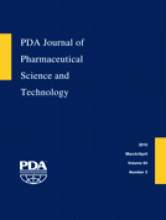Article CommentaryCOMMENTARY
Reducing Hospital-Acquired Infection by Quantitative Risk Modeling of Intravenous Bag Preparation
Edward C. Tidswell, Jim Rockwell and Marc-Oliver Wright
PDA Journal of Pharmaceutical Science and Technology March 2010, 64 (2) 82-91;
Edward C. Tidswell
Jim Rockwell

References
- 1.↵
- Broderick A.,
- Mori M.,
- Nettleman M. D.,
- Streed S. A.,
- Wenzel R. P.
- 2.↵
- Morrison A. J. Jr.,
- Kaiser D. L.,
- Wenzel R. P.
- 3.↵
- Wenzel R. P.,
- Osterman C. A.,
- Townsend T. R.,
- Veazey J. M. Jr.,
- Servis K. H.,
- Miller L. S.
- 4.↵
- Klevens R. M.,
- Edwards J. R.,
- Richards C. L.,
- Horan T. C.,
- Gaynes R. P.,
- Pollock D. A.,
- Cardo D. M.
- 5.↵
- Wenzel R. P.
- Pittet D.
- 6.↵
- Klevens R. M.,
- Morrison M. A.,
- Nadle J.,
- Petit S.,
- Gershman K.,
- Ray S.,
- Harrison L. H.,
- Lynfield R.,
- Dumyati G.,
- Townes J. M.,
- Craig A. S.,
- Zell E. R.,
- Fosheim G. E.,
- McDougal L. K.,
- Carey R. B.,
- Fridkin S. K.
- 7.↵
- Cosgrove S. E.,
- Sakoulas G.,
- Perencevich E. N.,
- Schwaber M. J.,
- Karchemer A. W.,
- Carmeli Y.
- 8.↵
- Blot S.,
- Vandewoude K.,
- Hoste E.,
- Colardyn F.
- 9.↵
- Wisplinghoff H.,
- Bischoff T.,
- Tallent S.,
- Seifert H.,
- Wenzel R.,
- Edmond M.
- 10.↵
- Diekema D.,
- Pfaller M.,
- Jones R.
- 11.↵
- Kresken M.,
- Hafner D.
- 12.↵
- Eggimann P.,
- Sax H.,
- Pittet D.
- 13.↵
- Öncü S.,
- Sakarya S.
- 14.↵
- Safdar N.,
- Maki D. G.
- 15.↵
Validation of moist heat sterilization processes: cycle design, development, qualification and ongoing control. PDA Technical Report 1 (revised 2007) 2006, 61 (S-1).
- 16.↵
- Darouiche R. O.,
- Raad I. I.,
- Heard S. O.,
- Thornby J. I.,
- Wenker O. C.,
- Gabrielli A.
- 17.↵
- Tidswell E. C.
- 18.↵
- Hillson D. A.
- 19.↵
- Tidswell E. C.
- 20.↵
- Tidswell E. C.
- 21.↵
- Tidswell E. C.,
- McGarvey B.
- 22.↵
- Tidswell E. C.,
- McGarvey B.
- 23.↵
- 24.↵
- Lee L. D.,
- Berkheiser M.,
- Jiang Y.,
- Hackett B.,
- Hachem R. Y.,
- Chemaly R. F.,
- Raad I. I.
- 25.↵
- 26.↵
- 27.↵
- 28.↵
- Augustowska M.,
- Dutkiewicz J.
- 29.↵
- Jaffal A. A.,
- Nsanze H.,
- Bener A.,
- Ameen A. S.,
- Banat I. M.,
- El Mogheth A. A.
- 30.↵
- Simon P. W.,
- Hillson D. A.,
- Newland K. E.
- 31.↵
Risk management. Australian/New Zealand Standard AS/NZS 4360:1999; New Zealand: Standards Australia/Standards New Zealand. Homebush NSW, 1999.
- 32.↵
Project management—part 2: vocabulary. British Standard BS6079-2:2000; British Standards Institute, London, UK, 2000.
- 33.↵
A risk management standard. Institute of Risk Management, London, UK, 2002.
- 34.↵
- 35.↵
- Tidswell E. C.,
- Bellinger M.,
- McCullough D.,
- Allexander A.
- 36.↵
- Schinabek M. K.,
- Ghannoum M. A.
- 37.↵
- Trissel L. A.,
- Gentempo J. A.,
- Saenz L. M.,
- Woodard M. Y.,
- Angeles C. H.
- 38.↵
- Sherertz R. A.,
- Bassetti S.,
- Bassetti-Wyss B.
- 39.↵
- Cooper M. S.
- 40.↵
- 41.↵
In This Issue
PDA Journal of Pharmaceutical Science and Technology
Vol. 64, Issue 2
March/April 2010
Reducing Hospital-Acquired Infection by Quantitative Risk Modeling of Intravenous Bag Preparation
Edward C. Tidswell, Jim Rockwell, Marc-Oliver Wright
PDA Journal of Pharmaceutical Science and Technology Mar 2010, 64 (2) 82-91;
Jump to section
Related Articles
- No related articles found.





